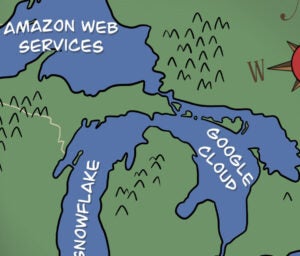 The competition among cross-device providers is no longer a one, two or even three-horse race, but looks more like a mad steeplechase with 20 animals of various sorts, including thoroughbreds, rabbits and perhaps snakes. The biggest consumer platforms, like Facebook and Google, are often given the best odds, but some dark horses are moving up in the pack.
The competition among cross-device providers is no longer a one, two or even three-horse race, but looks more like a mad steeplechase with 20 animals of various sorts, including thoroughbreds, rabbits and perhaps snakes. The biggest consumer platforms, like Facebook and Google, are often given the best odds, but some dark horses are moving up in the pack.
One such horse is Adobe, which is hard at work on its own cross-device ID that will take the form of a data-sharing cooperative among customers, AdExchanger has learned.
Adobe has begun actively recruiting co-op members, ahead of a beta release scheduled for November. By Q2 2016 the company hopes to be in-market with a solution, which will be baked into its Marketing Cloud products and perhaps some third-party platforms.
Speaking to a group of 30 customers and partners on a June 24 conference call, Adobe’s privacy product manager Vinay Goel said, “Adobe is [asking you to] grant Adobe the right to use anonymous authentication data as well as HTTP header information to build cross-device links. We are asking permission to use some of your anonymous data to build both a declared graph as well as a stitched graph to help fill in for situations where a consumer might not have signed in on a particular device.”
In plainer language, a participating co-op member such as Dell could opt in to share its logged-in user data with Adobe in a hashed (i.e., anonymized) form. In return for exposing its proprietary device linkage data to the co-op, Dell would get similar authenticated data back from all other co-op participants, helping Dell better connect the dots between its customers/prospects and their devices. Other co-op members would never have access to Dell’s audience PII, targeting segments, or any other user-level data – only the linkages it has established between users and their multiple devices/browsers.
On its conference call last month, Adobe execs claimed the company’s device graph has the potential to link up 45% of all consumer mobile devices in the US and Canada. If it pulls that off, co-op participants using Adobe’s four key Marketing Cloud products – Audience Manager (data-management platform), Analytics, Target (site personalization engine) and Media Optimizer (demand-side platform) – would see dramatic improvements in measurement and targeting as a result of unified consumer profiles. Adobe says there are some lesser use cases as well, such as improvements in A/B testing.
“We think we have a differentiated offering here from a deterministic scale point of view,” Adobe’s identity czar, Asa Whillock, told participants on the call. “The model that we’re putting forward of a cross-device cooperative… is saying, OK, if we can collect the data that we steward and offer that back to our customers, we have the ability to offer 45% coverage across the US and Canada.”
But Adobe’s data co-op is far from a slam dunk, especially when it comes to privacy compliance.
Since Adobe lacks direct consumer relationships of its own, it can only obtain device linkages by partnering with customers that have those authenticated relationships – hence the co-op structure. But several of those prospective co-op members are pushing back against the deal’s privacy underpinnings, including what they see as an inadequate system for tracking opt-outs from Adobe’s device graph.
Adobe has put several mechanisms in place to head off privacy concerns around the co-op. First, the company is requiring all co-op members to disclose their participation in Adobe’s program in their privacy policies. Second, Adobe says it will list all participating companies in a website about the program. Third, it will specify data use policies with its customers in new contractual language designed to protect both Adobe and its co-op members.
Finally, the company will offer a centralized opt-out tool that will provide users with visibility into the devices that have been linked to him or her.
“This addresses one of the key complaints regulators have,” Goel said. “We are showing consumers: Here is what we have.”
But the opt-out function, seemingly the most forward-thinking aspect of the program, has sparked serious concerns for many prospective co-op members. That’s because, as with other tracking systems, Adobe requires the use of a cookie to “remember” that a user has declined to participate. It’s one of the ironies of Internet tracking systems: If a user opts out and then clears her cookies, the opt-out is then forgotten and the user will again be tracked across devices.
The same problem applies to other opt-out systems, including those run by the Digital Advertising Alliance and TRUSTe.
But for some marketers considering joining the co-op, this could be a deal breaker.
“The risk for everybody is the user perception,” said one person on the call. “On sites where you’re logging on, the consumer has a natural expectation that, ‘You know me. I’ve told you that I’m opting out.'”
Said another: “I like the idea of the co-op, but it seems like the opt-out option is kind of flawed.”
“If I’m a customer coming to our site, I can see that being misleading,” said a third. “If you clear your cookies, and then the consumer comes and sees that they are being targeted and profiled again, that could be infuriating.”
Adobe executives on the call acknowledged the concerns, and pledged to “bring that feedback back to our engineers.”
It may be that privacy concerns will topple Adobe’s efforts, but many marketers will be rooting for the company as it seeks to develop a viable standalone alternative to the cross-device ID systems already on offer from Facebook and Google.
Facebook, of course, was first to market with its cross-device graph when it released its rebuilt Atlas ad server product in the fall of 2014. Google followed with its own cross-device tracking system, based in part on deterministic data (i.e., authenticated log-ins). But marketers see imperfections with those solutions, since for privacy reasons neither will pass back user-level IDs that customers could then use to measure and optimize campaigns within their data-management platform or demand-side platform of choice.
As of yet, no pure buy-side ad platform company has unveiled a cross-device measurement system pegged to authenticated audience data, but that may change next year if Adobe can make its case.
Adobe declined to comment for this story.













